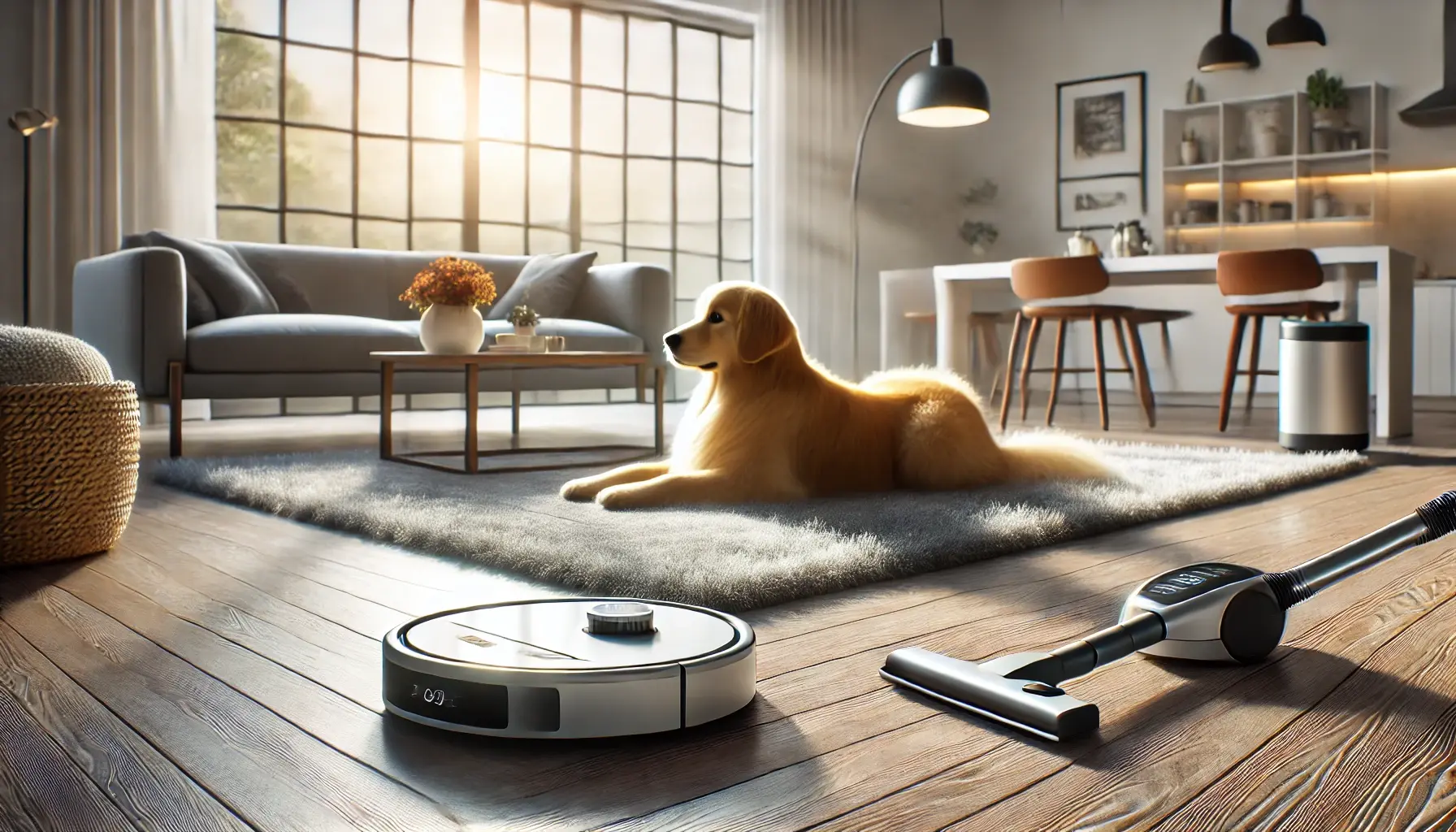Pet ownership can be a wonderful and fulfilling experience, but it does come with a few drawbacks—namely, dealing with pet hair. If you share your home with a shedding cat or dog, you’ve likely faced the challenge of keeping floors clean from tufts of fur. Fortunately, modern technology has come to the rescue with a growing variety of robot vacuums that specialize in picking up pet hair. In this comprehensive guide, we’ll discuss how to choose the best robot vacuum for pet hair, compare leading models, and share helpful tips for maintaining a clean, fur-free home.
Table of Contents
Why Consider a Robot Vacuum for Pet Hair
Keeping floors spotless when you have a pet can feel like a never-ending chore. The endless shedding and fur accumulation can add hours of extra cleaning to your weekly routine. That’s where a robot vacuum can be a game-changer. Designed to autonomously clean your floors on a pre-set schedule or whenever you command, these handy devices allow you to:
- Save Time: Instead of daily sweeping or vacuuming, you can run the robot vacuum multiple times a day—even when you’re away from home.
- Reduce Allergens: Pet dander and hair can exacerbate allergies. Regular automated cleaning helps to keep allergen levels to a minimum.
- Consistent Cleaning: Many models use sensors to navigate around the house, ensuring a thorough and efficient clean every time.
- Focus on Other Tasks: Free up your time for the more rewarding aspects of pet ownership, like playtime and bonding with your furry friend.
Key Features to Look For
When searching for the best robot vacuum for pet hair, not all models are created equal. While many can pick up basic dirt, you’ll want specific features that make them proficient at tackling fur and dander. Here are the top features to consider:
- Suction Power
High suction power is essential for lifting pet hair from carpets, rugs, and hard floors. This is especially true if you have a high-shedding breed or thick carpeting. - Brush Design
Look for tangle-free or self-cleaning brush rolls. Pet hair can wrap around traditional brush rolls, making them less effective and harder to maintain. - Navigation Technology
Advanced models use sensors or laser mapping to navigate around furniture and other obstacles. Good navigation ensures no area is missed, which is particularly critical for pet hair hidden under tables, couches, and corners. - Self-Emptying Feature
Some robot vacuums come with a self-emptying base, reducing the time and effort spent manually emptying the dustbin. This is incredibly helpful if your pet sheds heavily, requiring frequent bin emptying. - Battery Life and Recharge
Longer battery life means the vacuum can clean larger spaces without needing to recharge. Some models also feature “recharge and resume” capabilities, automatically returning to the dock to recharge before continuing where they left off. - Smart Connectivity
Many robot vacuums can connect to Wi-Fi, allowing you to schedule and monitor cleaning sessions via a smartphone app. Some are also compatible with virtual assistants like Alexa or Google Assistant for voice control.
Top Robot Vacuum Models for Pet Hair
1. iRobot Roomba i7+
Key Features
- Automatic Dirt Disposal: The i7+ comes with a Clean Base Automatic Dirt Disposal system, eliminating the need to empty the bin for weeks at a time.
- High-Efficiency Filter: Specifically designed to trap 99% of dog and cat allergens.
- Imprint Smart Mapping: Remembers multiple floor plans and can be directed to clean specific rooms with voice commands or the app.
Why It’s Great for Pet Hair
The dual multi-surface rubber brushes resist tangles, making this model highly effective at dealing with fur. The suction power is robust, and the self-emptying feature saves time—perfect for busy pet owners.
2. Shark IQ Robot Vacuum
Key Features
- Self-Cleaning Brushroll: The self-cleaning design is intended to remove hair wrap on its own.
- IQ Navigation: Methodically cleans row-by-row, ensuring total floor coverage.
- Large Capacity Base: Like the i7+, Shark’s self-emptying base holds dirt and debris for up to a month.
Why It’s Great for Pet Hair
Its powerful suction and self-cleaning brushroll make it particularly efficient at capturing pet hair without constant maintenance. The IQ navigation feature also ensures it doesn’t miss any fur-laden nooks.
3. Eufy RoboVac G30 Edge
Key Features
- Slim Design: At just under 3 inches tall, it can easily clean under furniture where dust bunnies and pet hair often accumulate.
- Smart Dynamic Navigation 2.0: Uses path tracking sensors to navigate your floors more efficiently than random-path models.
- Strong Suction: Delivers up to 2,000Pa of suction power, which is effective on both hard floors and low- to medium-pile carpets.
Why It’s Great for Pet Hair
The RoboVac G30 Edge is budget-friendly while still offering solid performance in picking up fur and dander. Its slim profile is especially helpful if your pet enjoys lounging under couches or beds.
4. Neato Botvac D7 Connected
Key Features
- D-Shape Design: This shape allows it to reach corners and edges that round robots might miss.
- LaserSmart Technology: Maps your home in real-time, ensuring thorough, methodical cleaning.
- Multiple Floor Plans: Ideal for multi-level homes, it can store up to three different floor maps.
Why It’s Great for Pet Hair
The D-shape design is a standout feature, as it helps in tackling pet hair that often accumulates around baseboards and in corners. The brushroll spans the full width of the vacuum’s front, maximizing coverage.
Maintenance and Care Tips
Even the best robot vacuum for pet hair will require some level of upkeep, particularly if you have a heavy shedder at home. Here are a few maintenance tips to keep your robot vacuum in tip-top shape:
- Regularly Empty the Dustbin
Even with a self-emptying base, you’ll need to replace or empty the larger dirtbag periodically. If you don’t have a self-emptying model, empty the dustbin after each session to maintain maximum suction power. - Clean the Brushes
Although many modern robot vacuums have self-cleaning brush systems, occasionally check the brushes for tangled hair or string. A pair of scissors or a hair removal tool often comes included with the vacuum for easy cleanup. - Check Sensors and Wheels
Over time, dust and hair can accumulate around the sensors and wheels, affecting the robot’s ability to navigate. A soft cloth or compressed air can help remove debris without damaging sensitive parts. - Filter Replacement
HEPA filters or other high-efficiency filters capture allergens but can clog quickly if you have multiple pets. Replace or wash the filters as recommended by the manufacturer (often every two to three months). - Routine Software Updates
Most modern robot vacuums have firmware that receives updates. Keep the robot’s app and software updated to benefit from improvements in navigation and cleaning efficiency.
How to Maximize Your Robot Vacuum’s Performance
To make the most out of your investment, consider these strategies:
- Pre-Clean High-Traffic Areas
Pick up large items, like toys or bones, to prevent obstruction. This makes it easier for your robot vacuum to navigate freely. - Create Virtual Boundaries
Use boundary strips or set up no-go zones in the app to keep the robot away from sensitive areas such as your pet’s food and water bowls. - Run Multiple Cycles
If you have multiple pets or a large home, schedule your robot vacuum to run more than once a day, especially during peak shedding seasons. - Combine with Handheld or Upright Vacuum
While a robot vacuum can handle day-to-day maintenance, doing a deeper clean every once in a while with a more powerful vacuum ensures your home remains truly fur-free.
Common Concerns and FAQs
Does the robot vacuum scare pets?
Some pets, especially cats, might be cautious around a moving robot at first. However, most pets learn to co-exist peacefully over time. To minimize stress, consider running the robot vacuum when you’re away or keep your pets in a separate room during cleaning.
How often should I run my robot vacuum?
This depends on the level of shedding. If you have heavy-shedding pets or multiple animals, running the vacuum once a day (or even twice daily) may be beneficial. For light shedders, three to four times a week could suffice.
Do robot vacuums work well on thick carpets?
While many robot vacuums handle low- and medium-pile carpets efficiently, thick or high-pile carpets can present a challenge. If you have thicker rugs, look for models specifically designed with higher suction and robust brushrolls.
Can a robot vacuum replace my traditional vacuum entirely?
Robot vacuums are excellent for maintaining overall cleanliness but might not entirely replace the deep-cleaning power of a traditional upright or canister vacuum. Most pet owners use a robot vacuum for daily maintenance and a more powerful vacuum for periodic thorough cleaning.
Final Thoughts
Investing in the best robot vacuum for pet hair can significantly cut down your cleaning routine, giving you more time to spend with your beloved furry companions. Whether you choose a self-emptying powerhouse like the iRobot Roomba i7+, or a budget-friendly, feature-rich model like the Eufy RoboVac G30 Edge, there is a perfect fit for every home and budget. By focusing on key features such as suction power, navigation technology, and brush design, you can find a robot vacuum that handles fur and dander efficiently. Combine it with regular maintenance and occasional deep cleaning, and you’ll be on your way to a home free of pesky pet hair tumbleweeds.
External Resource
For additional tips on maintaining a pet-friendly home, visit the ASPCA’s Pet Care page to learn more about keeping your furry friends happy and healthy.

